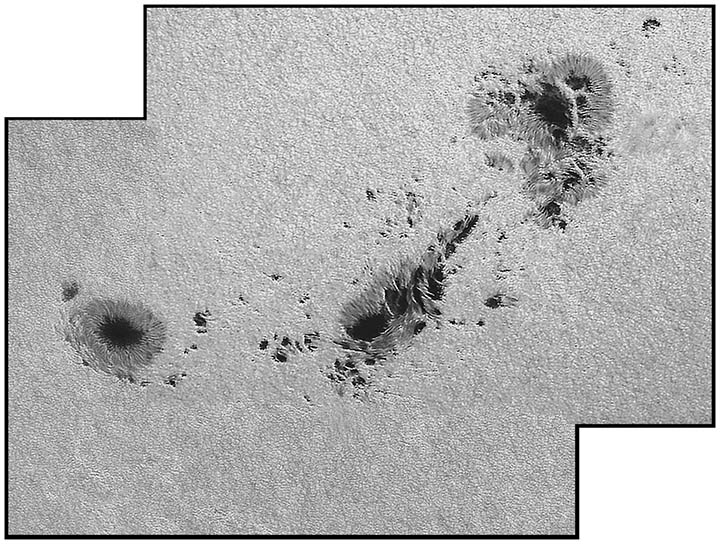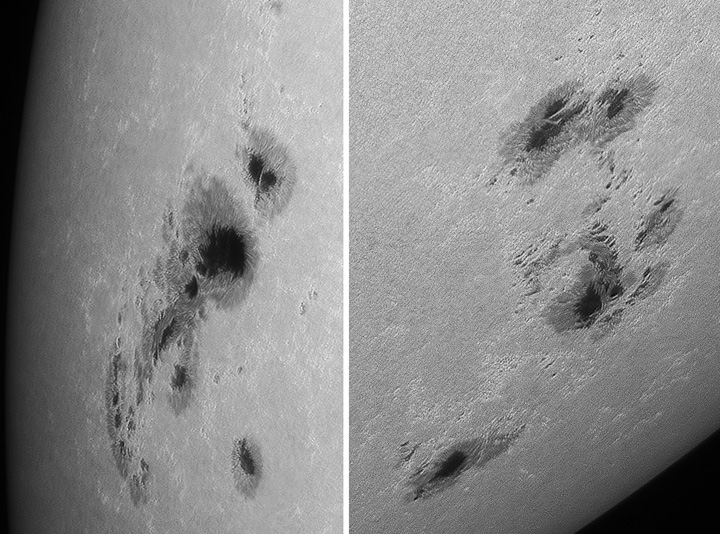| |
07/02/2012. The debut of TSAAS Mark-II (Tom Swift's Amazing Astronomical Suitcase v2.0) was a complete success. AR 1515 obliged with an M3.8 flare, the seeing was decent despite the heat (a thin layer of high clouds appeared to cap convection). I got some good narrow-band images, too, but it was the broadband "white light" image that stood out. Here's a crop of the largest spots. It's worth clicking for the full frame.

Click for full frame
AT10RC, full-aperture Baader solar film
Baader 685 IR-pass
Best 25% of 866 frames, 15ms, 4db, g=0.50
PGR Chameleon
The H-a frames are plagued by Newton's Rings. My use of higher contrast gamma values (0.85 for on-disk details rather than the PGR default of 1.00) makes them more than usually obnoxious. I've been looking for an effective way to flat-field out both the rings and dust shadows.
So far, no good:
- The diffuser I made for the RC is too dense. Even when I increased exposures by a factor of hundreds, I saw no useful image. I did see plenty of noise then, which would have introduced another class of problems.
- Grossly defocusing the telescope (5000 Robofocus units inward) produces a plausible flat. But the bands of Newton's rings in the flat do not line up with those in focused images. Presumably, changing the focus also changes the angle of incidence of the incoming light and that shifts the bands. Also, large-scale features like active regions and limb darkening introduce large artifacts.
- The forensic tool ImageJ should all me to identify and remove the frequency-domain signature of the rings, and the inverse transform should then produce an image free of the defect. I've had some small success. For now, the word "small" matters more than the word "success." (High frequency noise can be very nicely suppressed with a round trip through the FFT; it helps some with the rings, but it works wonders for harsh edges and electronic "grain.")
- Dynamic self-masking -- a digitally unsharpened version of the photo is used as a pseudo-flat to preferentially remove large scale gradations -- has worked reasonably well, but it results in greatly decreased dynamic range when used aggressively enough to make an impression on these rings.
Next, weather willing, I'll experiment with much thinner diffusing material.
07/04/2012. A very lightly frosted sheet of acetate (or some similar plastic material) from the inside of a cheap binder works better than anything yet for producing a solar flat. A single layer doesn't greatly increase exposure but allows a little too much detail to reach the chip. Doubling the material requires increasing exposure by a factor of 10 or more, but produces a flatter flat. This is likely the way to go. Now find a reliable source for this sort of material.
07/05/2012. Another mid-day spent with the AT10RC aimed at AR1515. The A-P handcontroller balked again and I got PulseGuide up and running in a few minutes -- it's a nice alternative and has its strengths, not least that it's easy to use remotely (the hand control was OK after baking in the sun for a couple of hours, so I'm thinking moisture). I took a white light flat by slewing a few minutes away from 1515 and defocusing about 30 units. Worked nicely; a diffuser would probably work better, but requires another couple of trips out to the 'scope. I waited for the X-flare we all think this group should produce, but this was not the day. All the white light images were made with the barlow on the PGR Chameleon's snout, a Baader 685nm IR filter, and a full-aperture Baader foil solar filter on the AT10RC. Exposures through thin high clouds were on the order of 14ms, gain 3 db, gamma = 0.50.

Best 20% of 866 frames
full-scale, cropped

Mosaic to fit the entire group in.
Best 20% of 866 frames, times two.

20% of 866 frames

16ms, 5db, gamma=0.50
Lunt THa60DS50.
Best 40% of 400 frames.
7/07/2012. I prepped some prints for Sarah Mac's 30th birthday and had a few free hours with the Sun high in the sky. Naturally, I wanted a last look at AR1515 and a first look at AR1520. Here are two massive sunspot groups: one leaving, one entering the stage. 1515 finally threw it's X flare last evening after the Sun went behind the house. From the looks of it, 1520 will be taking over where 1515 leaves off:

Newcomer AR1520 (left) and Departing AR1515
1520: best 15% of 1280 frames. 1515: mosaic of the best 30% of 400 times two.
All with the AT10RC, Baader AstroSolar film,
PGR Chameleon, barlow, and Baader
NIR 685
While setting up, the Pyramid power supply immediately went into "protected" mode presumably because of overheating (today's high was a little cooler than recent highs, only 97° fondly F), so I recabled the TSAAS to run from a 12v deep cycle battery. It worked exactly as planned, took only a couple of minutes, and worked like a charm. Based on this week's experience, there are some internal cables to reroute, mainly for the PulseGuide serial cable when the hand control fails or when remote pointing is important. It would be nice to be able to bring the control signal out through one of the sealed holes rather than through a slightly open lid, but that's really the only issue so far. Since we now know it works, it's time to label all the wires so everything stays sane (sane-ish).
:: top ::
Except where noted, solar photos are made with a Point Grey Research Chameleon camera behind a Lunt Solar Systems 60mm THa solar telescope double-stacked wtih a 50mm front etalon for an achieved bandwidth of about 0.55 Angstroms. The telescope uses a B600 blocking filter and is mounted piggyback with an Astro-Tech 10-inch Ritchey-Chretien (carefully capped!) on an Astro-Physics Mach1GTO mount. An Acer Aspire One netbook running Point Grey's Flycap software provides camera control and capture services via USB 2.0. Images typically begin as 20 second AVI's captured at 15 fps. 300 frame clips are aligned and stacked using Registax 6 or AVIStack 2.0. The resulting files are processed via wavelet functions in Registax and / or the FocusMagic 3.0.2 deconvolution plug-in in Photoshop CS4. (PixInsight is rapidly supplanting some of those steps.) The imaging train usually includes an Orion "Shorty" 2x barlow screwed into the 1.25-inch prime-focus snout. Exposures are on the order of 4-8 ms with gain set to 10-12 db, or 12-18ms at 0 gain. The barlow is sometimes replaced by an Antares 0.5x telecompressor sandwiched between the 1.25-inch snout and the C-adapter on the PGR Chameleon; this produces a full-disk image (during most of the year) and allows exposures in the 1ms range with slightly less gain. A RoboFocus motor with a timing belt looped around the stock (or, sometimes, a Feathertouch) focus knob enables remote operation.
|





